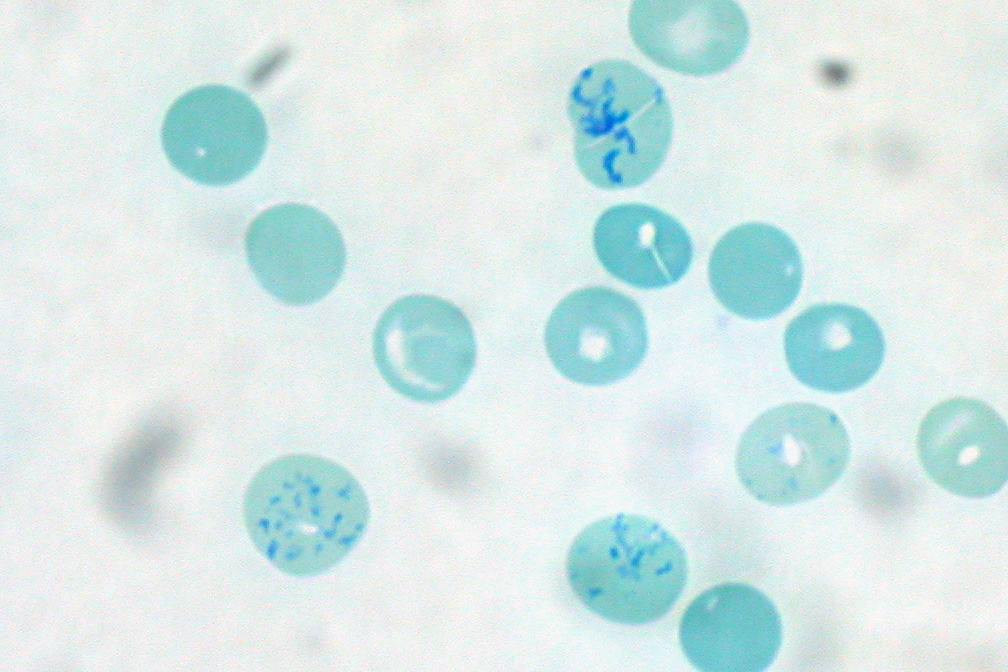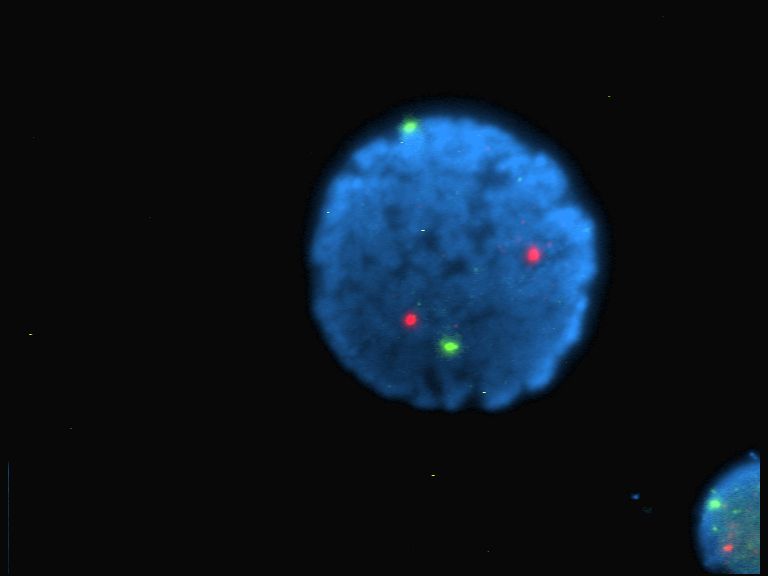|
Reticulocyte
In hematology, reticulocytes are immature red blood cells (RBCs). In the process of erythropoiesis (red blood cell formation), reticulocytes develop and mature in the bone marrow and then circulate for about a day in the blood stream before developing into mature red blood cells. Like mature red blood cells, in mammals, reticulocytes do not have a cell nucleus. They are called reticulocytes because of a reticular (mesh-like) network of ribosomal RNA that becomes visible under a microscope with certain stains such as new methylene blue and Romanowsky stain. Clinical significance To accurately measure reticulocyte counts, automated counters use a combination of laser excitation, detectors and a fluorescent dye that marks RNA and DNA (such as titan yellow or polymethine). Reticulocytes appear slightly bluer than other red cells when looked at with the normal Romanowsky stain. Reticulocytes are also relatively large, a characteristic that is described by the mean corpuscular ... [...More Info...] [...Related Items...] OR: [Wikipedia] [Google] [Baidu] |
Reticulocytosis
Reticulocytosis is a laboratory finding in which the number of reticulocytes (immature red blood cells) in the bloodstream is elevated. Reticulocytes account for approximately 0.5% to 2.5% of the total red blood cells in healthy adults and 2% to 6% in infants, but in reticulocytosis, this percentage rises. Reticulocytes are produced in the bone marrow and then released into the bloodstream, where they mature into fully developed red blood cells between 1-2 days. Reticulocytosis often reflects the body’s response to conditions rather than an independent disease process and can arise from a variety of causes such as blood loss or anemia. Mechanism Reticulocytosis results from the body’s physiological response to an increased need for red blood cells. When red blood cells are destroyed or lost, tissues experience low oxygen levels causing the kidneys to release the hormone erythropoietin. Erythropoietin signals the bone marrow to accelerate the production of red blood cells throu ... [...More Info...] [...Related Items...] OR: [Wikipedia] [Google] [Baidu] |
Reticulocyte Production Index
The reticulocyte production index (RPI), also called a corrected reticulocyte count (CRC), is a calculated value used in the diagnosis of anemia. This calculation is necessary because the raw reticulocyte count is misleading in anemic patients. The problem arises because the reticulocyte count is not really a ''count'' but rather a ''percentage'': it reports the number of reticulocytes as a percentage of the number of red blood cells. In anemia, the patient's red blood cells are depleted, creating an erroneously elevated reticulocyte count. Physiology Reticulocytes are newly produced red blood cells. They are slightly larger than totally mature red blood cells, and have some residual ribosomal RNA. The presence of RNA allows a visible blue stain to bind or, in the case of fluorescent dye, result in a different brightness. This allows them to be detected and counted as a distinct population.Adamson JW, Longo DL. Anemia and polycythemia. ''in:'' Braunwald E, et al. ''Harrison's ... [...More Info...] [...Related Items...] OR: [Wikipedia] [Google] [Baidu] |
Anemia
Anemia (also spelt anaemia in British English) is a blood disorder in which the blood has a reduced ability to carry oxygen. This can be due to a lower than normal number of red blood cells, a reduction in the amount of hemoglobin available for oxygen transport, or abnormalities in hemoglobin that impair its function. The name is derived . When anemia comes on slowly, the symptoms are often vague, such as Fatigue, tiredness, weakness, shortness of breath, headaches, and a Exercise intolerance, reduced ability to exercise. When anemia is acute, symptoms may include confusion, lightheadedness, feeling like one is going to pass out, Syncope (medicine), loss of consciousness, and polydipsia, increased thirst. Anemia must be significant before a person becomes noticeably Pallor, pale. Additional symptoms may occur depending on the underlying cause. Anemia can be temporary or long term and can range from mild to severe. Anemia can be caused by blood loss, decreased red blood cel ... [...More Info...] [...Related Items...] OR: [Wikipedia] [Google] [Baidu] |
New Methylene Blue
is an organic compound of the thiazine class of heterocycles. It is used as a stain and as an antimicrobial agent. It is classified as an azine dye, and the chromophore is a cation, the anion is often unspecified. Applications NMB is a staining agent used in diagnostic cytopathology and histopathology, typically for staining immature red blood cells. It is a supravital stain. It is closely related to methylene blue, an older stain in wide use. Safety New methylene blue is toxic. Skin contact or inhalation should be avoided. See also * Methylene blue Methylthioninium chloride, commonly called methylene blue, is a salt used as a dye and as a medication. As a medication, it is mainly used to treat methemoglobinemia. It has previously been used for treating cyanide poisoning and urinary trac ... References {{DEFAULTSORT:New Methylene Blue Biochemistry detection methods Thiazine dyes Vital stains Histology ... [...More Info...] [...Related Items...] OR: [Wikipedia] [Google] [Baidu] |
Red Blood Cell
Red blood cells (RBCs), referred to as erythrocytes (, with -''cyte'' translated as 'cell' in modern usage) in academia and medical publishing, also known as red cells, erythroid cells, and rarely haematids, are the most common type of blood cell and the vertebrate's principal means of delivering oxygen () to the body tissue (biology), tissues—via blood flow through the circulatory system. Erythrocytes take up oxygen in the lungs, or in fish the gills, and release it into tissues while squeezing through the body's capillary, capillaries. The cytoplasm of a red blood cell is rich in hemoglobin (Hb), an iron-containing biomolecule that can bind oxygen and is responsible for the red color of the cells and the blood. Each human red blood cell contains approximately 270 million hemoglobin molecules. The cell membrane is composed of proteins and lipids, and this structure provides properties essential for physiological Cell (biology), cell function such as erythrocyte deformabil ... [...More Info...] [...Related Items...] OR: [Wikipedia] [Google] [Baidu] |
Fluorophore
A fluorophore (or fluorochrome, similarly to a chromophore) is a fluorescent chemical compound that can re-emit light upon light excitation. Fluorophores typically contain several combined aromatic groups, or planar or cyclic molecules with several π bonds. Fluorophores are sometimes used alone, as a tracer in fluids, as a dye for staining of certain structures, as a substrate of enzymes, or as a probe or indicator (when its fluorescence is affected by environmental aspects such as polarity or ions). More generally they are covalently bonded to macromolecules, serving as a markers (or dyes, or tags, or reporters) for affine or bioactive reagents (antibodies, peptides, nucleic acids). Fluorophores are notably used to stain tissues, cells, or materials in a variety of analytical methods, such as fluorescent imaging and spectroscopy. Fluorescein, via its amine-reactive isothiocyanate derivative fluorescein isothiocyanate (FITC), has been one of the most popular fluorophores ... [...More Info...] [...Related Items...] OR: [Wikipedia] [Google] [Baidu] |
In Vitro
''In vitro'' (meaning ''in glass'', or ''in the glass'') Research, studies are performed with Cell (biology), cells or biological molecules outside their normal biological context. Colloquially called "test-tube experiments", these studies in biology and its subdisciplines are traditionally done in labware such as test tubes, flasks, Petri dishes, and microtiter plates. Studies conducted using components of an organism that have been isolated from their usual biological surroundings permit a more detailed or more convenient analysis than can be done with whole organisms; however, results obtained from ''in vitro'' experiments may not fully or accurately predict the effects on a whole organism. In contrast to ''in vitro'' experiments, ''in vivo'' studies are those conducted in living organisms, including humans, known as clinical trials, and whole plants. Definition ''In vitro'' (Latin language, Latin for "in glass"; often not italicized in English usage) studies are conducted ... [...More Info...] [...Related Items...] OR: [Wikipedia] [Google] [Baidu] |
Cell-free System
A cell-free system is an ''in vitro'' tool widely used to study biological reactions that happen within cells apart from a full cell system, thus reducing the complex interactions typically found when working in a whole cell. Subcellular fractions can be isolated by ultracentrifugation to provide molecular machinery that can be used in reactions in the absence of many of the other cellular components. Eukaryotic and prokaryotic cell internals have been used for creation of these simplified environments. These systems have enabled cell-free synthetic biology to emerge, providing control over what reaction is being examined, as well as its yield, and lessening the considerations otherwise invoked when working with more sensitive live cells. Types Cell-free systems may be divided into two primary classifications: cell extract-based, which remove components from within a whole cell for external use, and purified enzyme-based, which use purified components of the molecules known to be ... [...More Info...] [...Related Items...] OR: [Wikipedia] [Google] [Baidu] |
MRNA
In molecular biology, messenger ribonucleic acid (mRNA) is a single-stranded molecule of RNA that corresponds to the genetic sequence of a gene, and is read by a ribosome in the process of Protein biosynthesis, synthesizing a protein. mRNA is created during the process of Transcription (biology), transcription, where an enzyme (RNA polymerase) converts the gene into primary transcript mRNA (also known as pre-mRNA). This pre-mRNA usually still contains introns, regions that will not go on to code for the final amino acid sequence. These are removed in the process of RNA splicing, leaving only exons, regions that will encode the protein. This exon sequence constitutes mature mRNA. Mature mRNA is then read by the ribosome, and the ribosome creates the protein utilizing amino acids carried by transfer RNA (tRNA). This process is known as Translation (biology), translation. All of these processes form part of the central dogma of molecular biology, which describes the flow of geneti ... [...More Info...] [...Related Items...] OR: [Wikipedia] [Google] [Baidu] |
Translation (biology)
In biology, translation is the process in living Cell (biology), cells in which proteins are produced using RNA molecules as templates. The generated protein is a sequence of amino acids. This sequence is determined by the sequence of nucleotides in the RNA. The nucleotides are considered three at a time. Each such triple results in the addition of one specific amino acid to the protein being generated. The matching from nucleotide triple to amino acid is called the genetic code. The translation is performed by a large complex of functional RNA and proteins called ribosomes. The entire process is called gene expression. In translation, messenger RNA (mRNA) is decoded in a ribosome, outside the nucleus, to produce a specific amino acid chain, or polypeptide. The polypeptide later protein folding, folds into an Activation energy, active protein and performs its functions in the cell. The polypeptide can also start folding during protein synthesis. The ribosome facilitates decoding ... [...More Info...] [...Related Items...] OR: [Wikipedia] [Google] [Baidu] |
Mean Corpuscular Volume
The mean corpuscular volume, or mean cell volume (MCV), is a measure of the average volume of a red blood corpuscle (or red blood cell). The measure is obtained by multiplying a volume of blood by the proportion of blood that is cellular (the hematocrit), and dividing that product by the number of erythrocytes (red blood cells) in that volume. The mean corpuscular volume is a part of a standard complete blood count. In patients with anemia, it is the MCV measurement that allows classification as either a microcytic anemia (MCV below normal range), normocytic anemia (MCV within normal range) or macrocytic anemia (MCV above normal range). Normocytic anemia is usually deemed so because the bone marrow has not yet responded with a change in cell volume. It occurs occasionally in acute conditions, namely blood loss and hemolysis. If the MCV was determined by automated equipment, the result can be compared to RBC morphology on a peripheral blood smear, where a normal RBC is about t ... [...More Info...] [...Related Items...] OR: [Wikipedia] [Google] [Baidu] |




